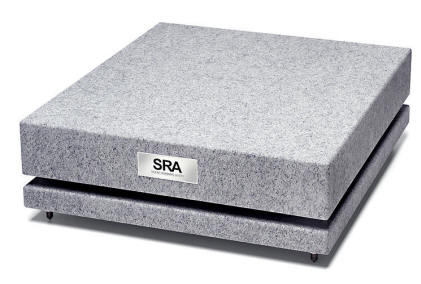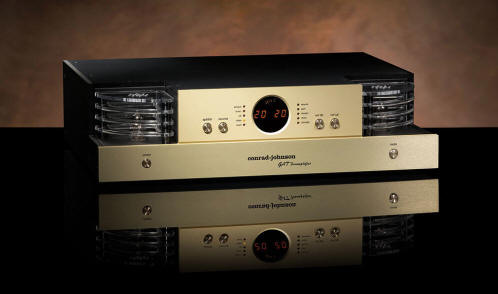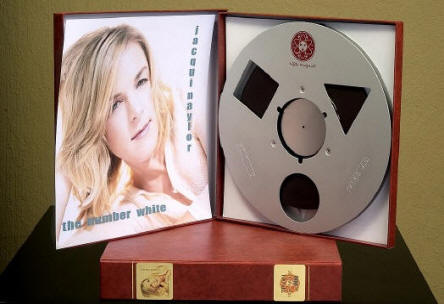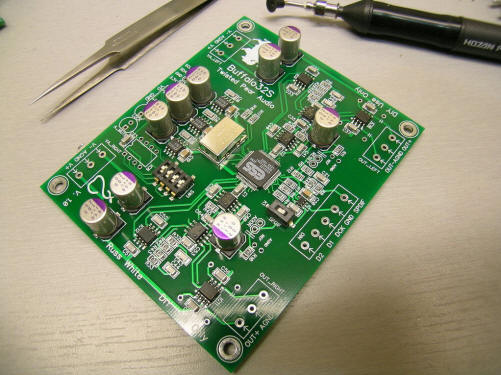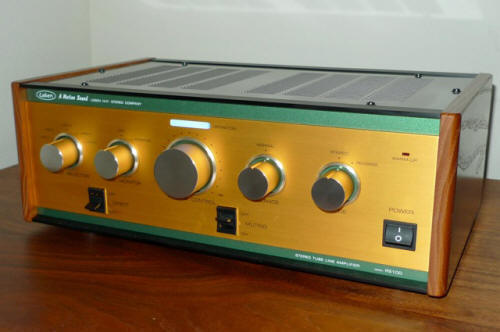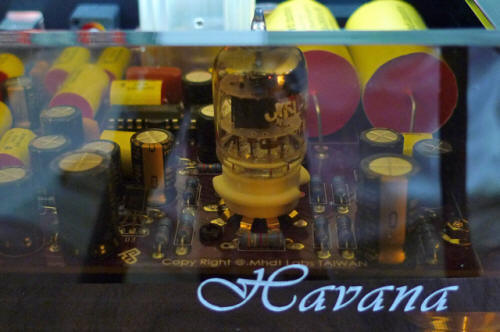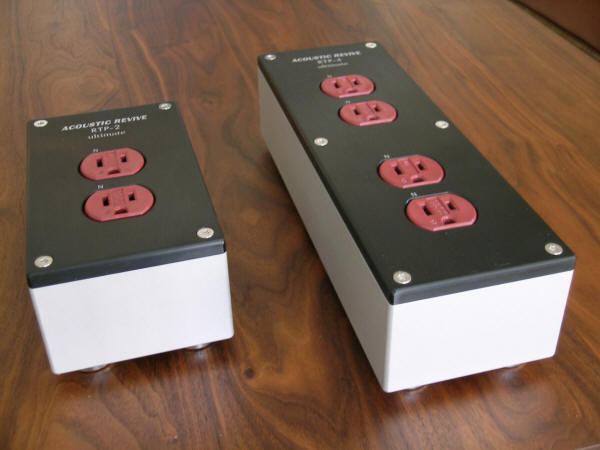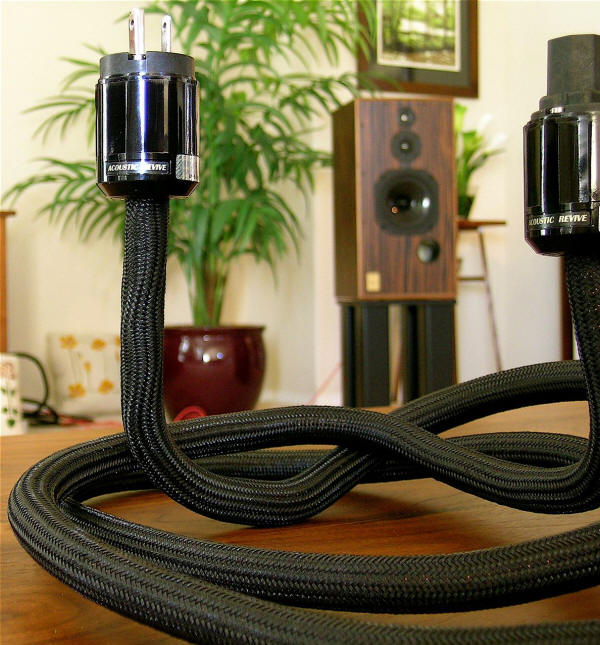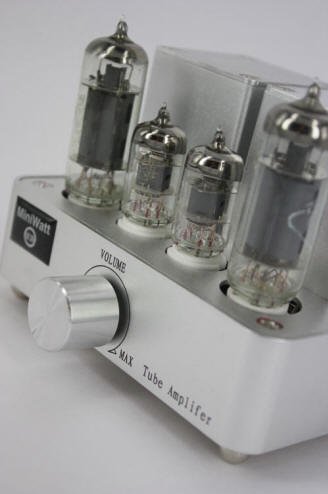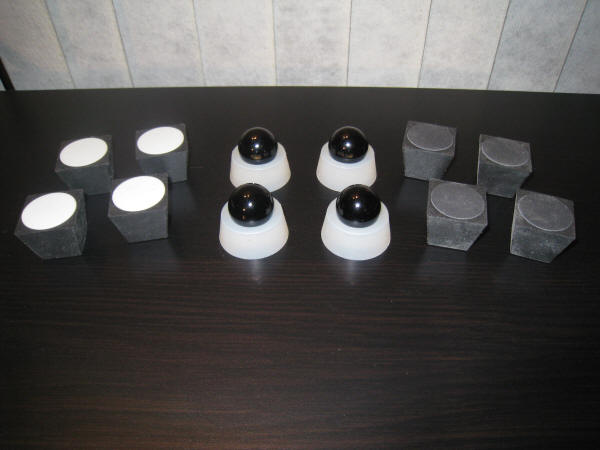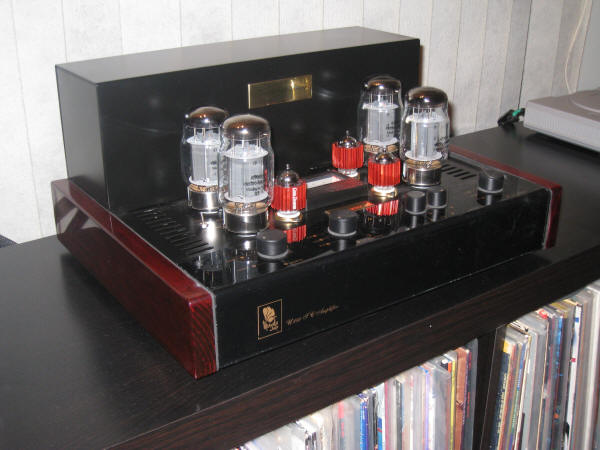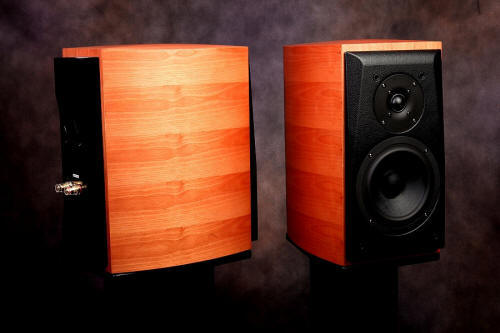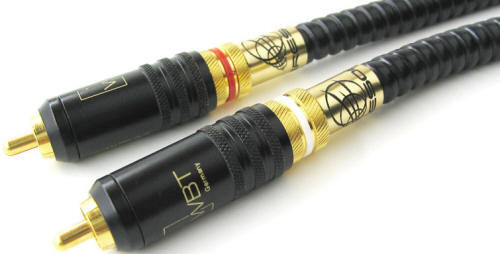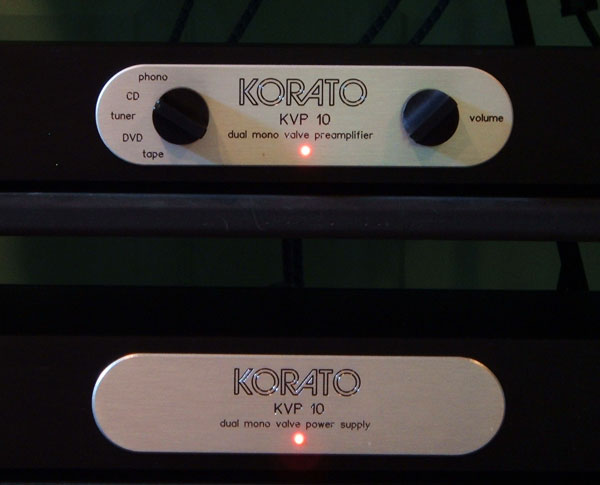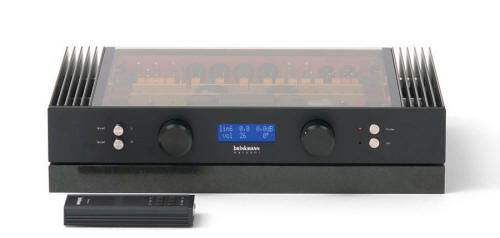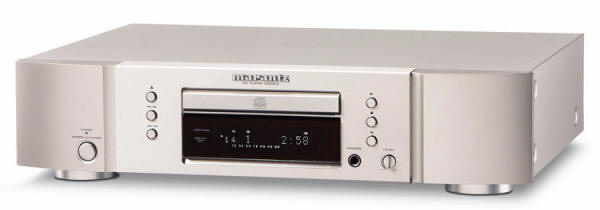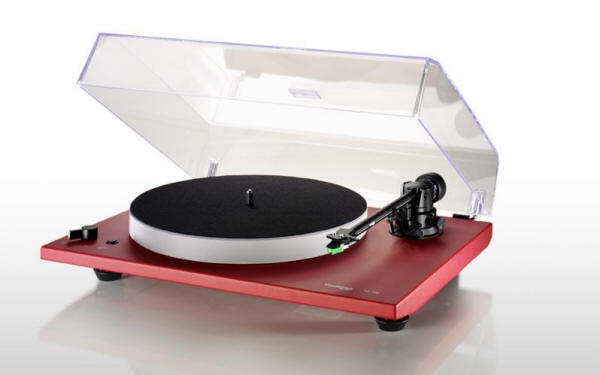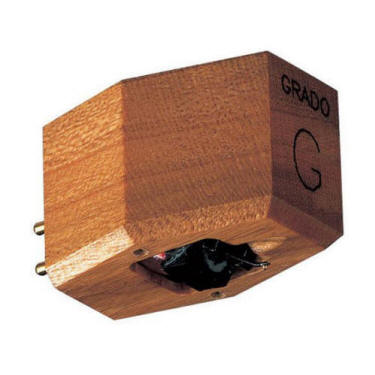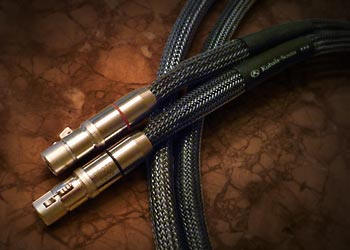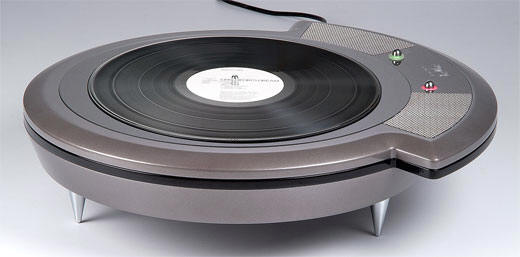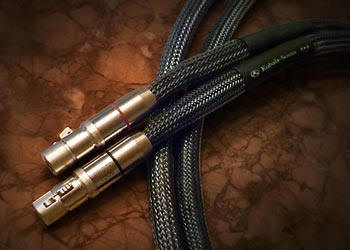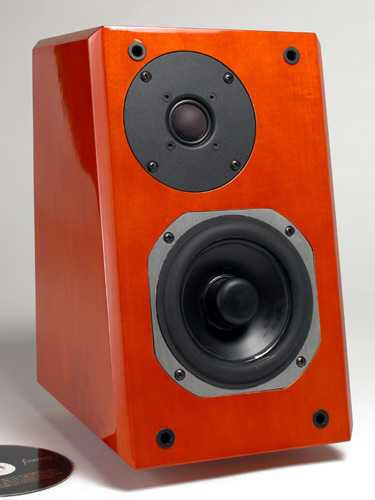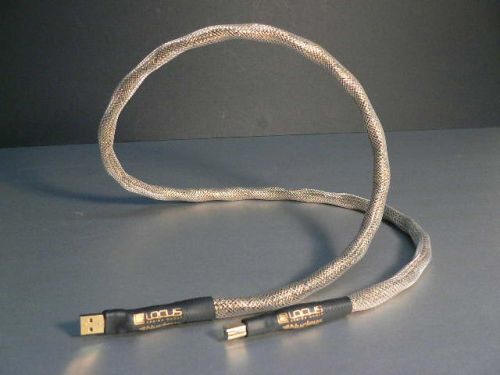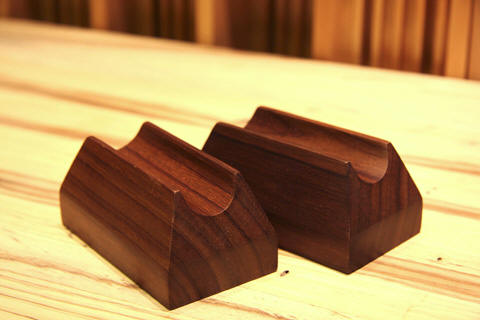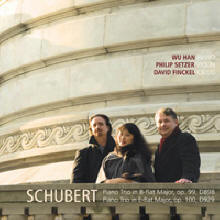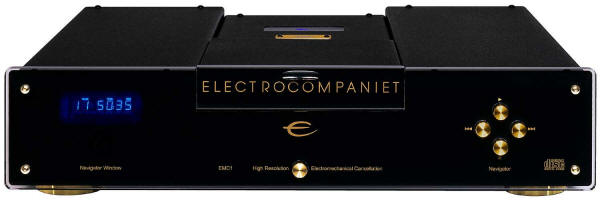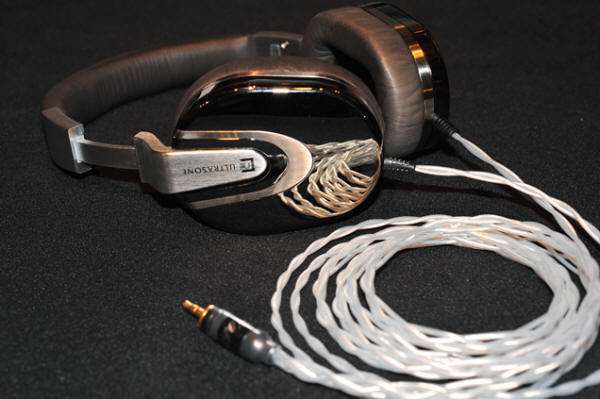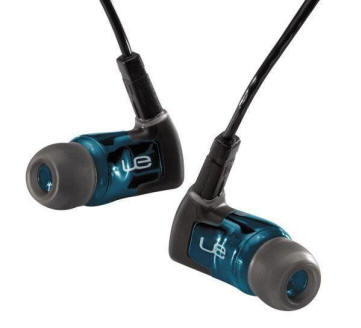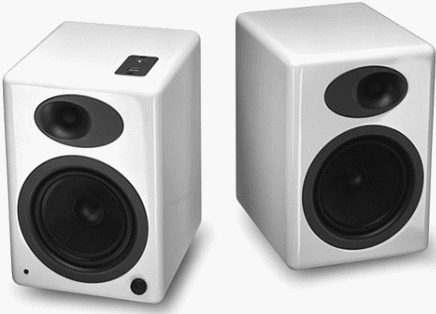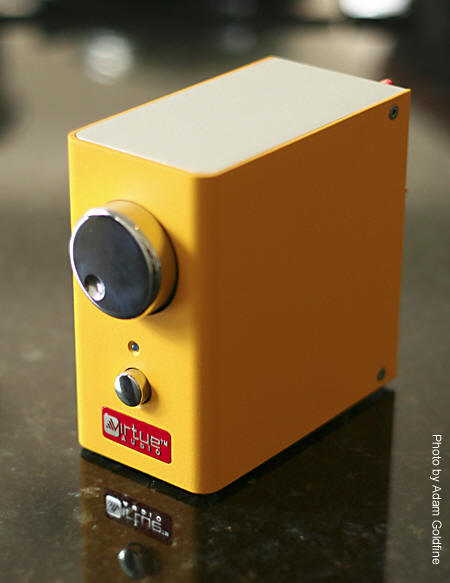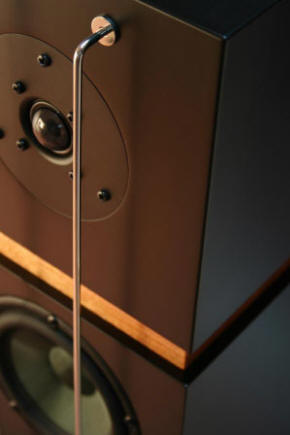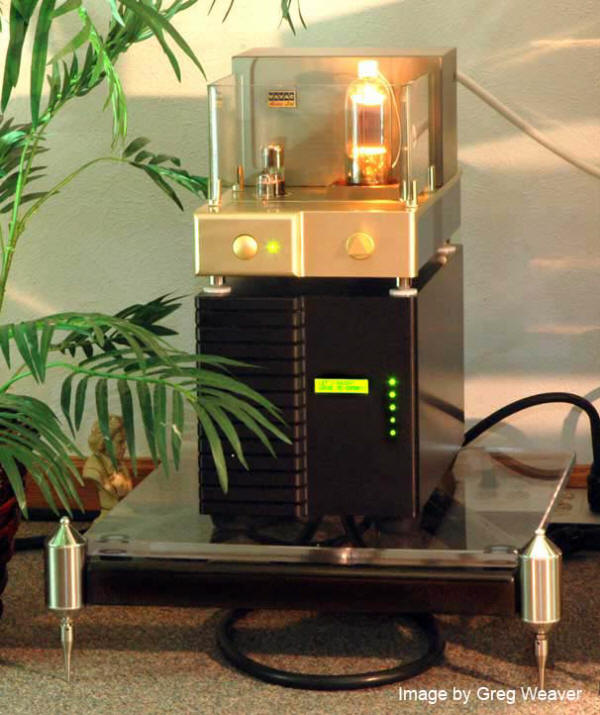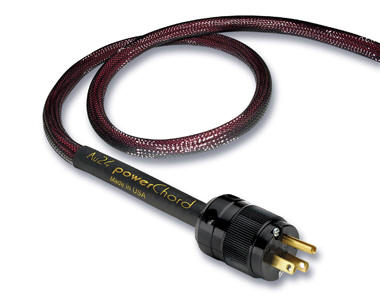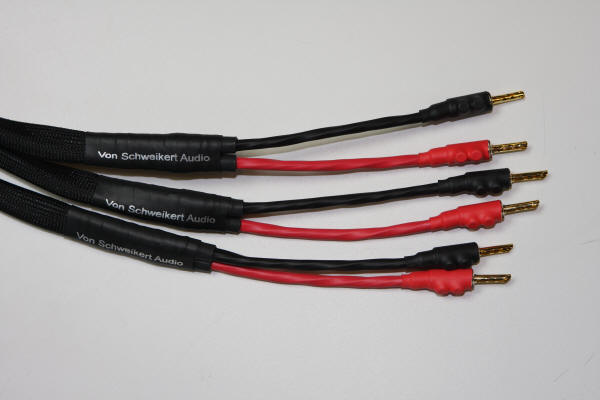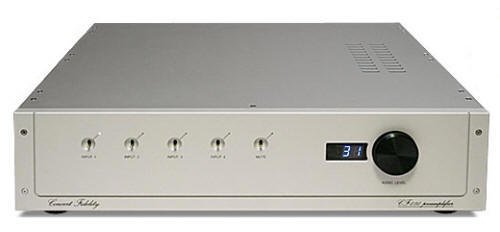|
You are reading the older HTML site Positive Feedback ISSUE 46november/december 2009
The 6th Annual Positive Feedback Online's Writers' Choice Awards - for 2009
Beginning at the end of 2003, PFO established its first annual awards for fine audio. The Brutus Award was established for the best that Dave Clark and I had heard in our own listening rooms during that year. You can think of it as our equivalent of an "Editors' Choice" award. The Gizmo Award, on the other hand, was established in memory of my very good audio friend, Harvey "Gizmo" Rosenberg, and is given by me to the most conspicuous audiomaniac(s) of the year. Only one Gizmo is given per year. The following is an opportunity for our editors and writers to recognize superior merit in the audio arts though their "Writers' Choice Awards". Our writers and reviewers have been given broad leeway to cite excellence in fine audio wherever they find it: products, people, recordings, events, groups, etc., so that our readers can be better informed. It is our hope that you will find the PFO Writers' Choice Awards to be helpful to you in your audio journey. All the best, David W. Robinson, Editor-in-Chief
Silent Running Audio "VR" Series isoBASE Platform How do you make a 10K amplifier sound like a $300 receiver? Easy! Try putting your state-of-the-art amplifier on the floor or carpet. To circumvent this and a host of other issues, Kevin Tellekamp, the man behind Silent Running Audio, developed the "VR" Series isoBASE equipment platforms. Simply put, Tellekamp's goal is, "avoiding turning something that isn't a problem into something that is a problem." In other words, the isoBASEs prevent the reduction of vibrations at one frequency from at the same time, abnormally exciting another frequency within that piece of equipment. Tellekamp also eschews the one size fits all approach to vibration isolation. Instead, the "thermal reactive system profile" of each isoBASE is custom tailored to eliminate sonic anomalies, both over the broadest possible bandwidth and at the highest possible amplitude, for each component. This type of attention to detail is made possible by SRA's extensive database containing among other things, information on each component's transmission curves. Now my front-end and source components have happily nested in a Silent Running Audio Craz rack (with the VPI table sitting on an isoBASE on top shelf) for quite some time. Just recently, I decided to take the plunge and see if adding isoBASES under both my conrad-johnson TEA1bc tubed phono stage and LP 140M tube amplifiers would yield even further sonic benefits. There was no question whatsoever that both units benefitted from sitting on isoBASEs; much to my surprise, however, the biggest sonic improvement came from isolating the conrad-johnson tube amplifiers. The end result was an appreciable drop in the system's noise floor and colorations resulting in an even greater sense of hall acoustics and retrieval of buried details. At the same time, dynamic accents were more defined, low frequencies were cleaner and tighter and instruments were more three dimensional. In reality, the SRA isoBASEs allow audiophiles to fully realize the potential of all the components in their systems as well being as a cost effective alternative to upgrading equipment. $600 to $6000 each (based on the specific SRA model and total square inches). Silent Running Audio www.silentrunning.com.
conrad-johnson GAT Preamplifier Parting is such sweet sorrow. In this case, as in the original Shakespearean play, the GAT symbolizes both pain and pleasure. The pain portion relates to both the loss of Carnell Gatling, the former and much beloved head of customer service at conrad-johnson in whose memory the unit was named and the retirement of the ART Series 3, my long time companion (and reference) for close to twelve years. At the time of the ART Series 1's release, conrad-johnson wrote "We expect it to serve as our own reference for many years to come." One has to suspect that even in their wildest dreams, Bill Conrad and Lew Johnson didn't expect it would take them 13 years to finally top the performance of the ART. The limited edition GAT (250 units will be built) remains true to conrad-johnson's basic design philosophy (dating back to the dual mono Premier 7 preamplifier) of maintaining temporal accuracy. Like the ART, the GAT is a zero negative feedback design (either local or global feedback), "consisting of a single amplifier stage incorporating one composite triode comprised of paralleled sections of a high-transconductance miniature dual triode vacuum tube." Perhaps the most significant circuit change incorporated in the GAT involves the addition of a MOSFET output buffer stage. This buffer stage addresses the issue of asymmetrical output impedance differences between the positive and negative signals as well as reducing output impedance by roughly a factor of five and making the preamplifier less sensitive to cables and amplifiers. I'm not going to beat around the bush. The GAT's performance is extraordinary, possessing an exceptional balance between resolution and musicality. Like the legendary Michael Jordan, the GAT significantly improves the performance of all the components around it. Perhaps conrad-johnson's most neutral piece to date, the GAT works synergistically with the Teflon capacitor equipped TEA phono stage and LP140M amplifiers. The very first quality that comes through from day one is the unit's vanishingly low noise floor. Just as impressive is the GAT's recreation of the size, openness and decay qualities of the recording venue whether the source material is Harmonia Mundi's Carmina Burana Vol.2 on LP or The Tape Project's 15 ips, 2-track reel-to-reel tape of Hindemith's Violin Concerto on. Lastly, low frequencies are extended, dynamic, fast and tight, for either a tube or solid-state preamplifier. I reckon it's going to be a long time again before the team of Conrad and Johnson top this effort! Conrad-johnson design, inc. www.conradjohnson.com
The Tape Project Reel to Reel Reissue Series 1 https://positive-feedback.com/Issue46/tape_project.htm It's hard to imagine there being any better sounding software than the super audiophile mastered 15-ips, 2-track, reel-to-reel tapes from The Tape Project. No product of the year awards list is replete without software to play on the system. This year there were more nominees than ever in the software category to choose among including Music Matters and Analogue Productions sensational 45 rpm Blue Note and Impulse jazz remasters as well as Analogue Productions newly released 45 rpm version of The Power of the Orchestra. That said, this years hands down winner this year in the software category is the master-tape like sound of The Tape Project's first series of ten, 15-ips, ¼-inch, 2-track reel-to-reel-tapes. Make no mistake. These recordings are not your usual audiophile fare. The Tape Project's Series 1 releases were chosen by the companies three co-founders Dan "Doc" Schmalle, Paul "High and Outside" Stubblebine and Michael "Romo" Romanowski and consist of an eclectic collection of music including jazz, blues, and classical titles. The Tape Project reel-to-reel tapes are everything the "mass produced" prerecorded tapes of the ‘50s and ‘60s weren't. Schmalle, Stubblebine and Romanowski use state-of-the-art tape transports, electronics and tape, in the production of these recordings. Even the finest high-end audio components are put to the ultimate test. Standout releases from The Tape Project's first series and representing the finest examples of performance, sound and engineering include the Kenneth Wilkinson engineered Bruch: Scottish Fantasy/Hindemith:Violin Concerto, one of the all time great live jazz trio recordings Waltz for Debby and one of Keith O. Johnson's finest efforts, Arnold Overtures. To quote Harry Weisfeld, owner of a sizable collection of master tapes, "this is what we should have done from the beginning." After listening to these reel-to-reel tapes, it's hard to argue with Harry. Every audiophile, even those who don't own a reel to reel tape deck, owe it to themselves to hear all the information that's lost in the mastering and production of LPs and CDs. Price: Individual 15-ips/2-track tapes (two reels): $500; Selective subscription, Series 1 and 2: $1800 for six tapes (can buy additional tapes @ $300 each); Full subscription Series 1 and 2: $3000 for all ten tapes. Note can't combine series 1 and 2 subscriptions. The Tape Project www.tapeproject.com.
Dynavector XX2 cartridge This is not a cartridge for little old ladies in white gloves with tea cups and doilies, though it could be. Music is sometimes bold and brash, sometimes it's quietly delicate like tea cups on doilies and sometimes it's all of that within a three minute passage, and so too is the XX2. I love this cartridge and only wish I could have partaken further up the Dynavector chain. Yes, the XX2 is not as refined as the former top of the line XV1t, but it's close in terms of dynamic expression, including a propulsive bass region that kicked the doilies out of pretty much every other cartridge I've had in my system over the past twenty years while still serving a beautiful cup of tea, or at least music. Frenetic Colorful without being colored, neutral without sounding neutered and dynamic without being frenetic. Sure, good recordings sound marvelous and bad recordings sound like, well... bad recordings, but the XX2 doesn't make the presentation go from bad to worse. With a liveliness that reminded this listener of the tension inherent in a live performance that's nearly always absent from a recorded performance (I always listen knowing the recording has the "mistakes" edited out, right?). Its performance underscored how constrained most cartridges are. The XX2 reproduces music well and wildly enough to spill some milk, but without leaving the original experience of live music behind. While it is dynamically punchy it's also got a light enough touch to show off low level high hat work deep inside a busy recording. Not obviously analytical or romantic, you get a focused rendering of music at its most exuberant. The long, naked cantilever looks like an ungainly problem or cantilever waiting to be snapped off during setup but it's dramatic outline makes cartridge alignment easier to see. In the several times I've mounted or remounted the cartridge, I've had very little trouble getting the set up "just right." The cartridge's shortcomings, if I've eyed them properly, are that I'd like a bit more resolution and a slightly more open top end, and I do mean slightly. Very satisfying performance for a mid-level cartridge ($1850). Getting really close to the sound of music and a totally great, best buy.
Twisted Pair Audio Buffalo32S ($449 and then some, depending on configuration) A DIY kit (www.twistedpearaudio.com) that employs ESS Technology's 32 Bit Sabre chip. The DAC board is sold ($449) assembled, though it requires assembly of two power supplies (one for digital, one analog), though I bought a second power supply for dual analog power supplies. My configuration cost about $750, sans chassis. ESS Technology's DACs play a role in PeachTree Audio's Nova DAC \ integrated amp being well received; though the Nova only sports ESS' 24 bit DAC. Those with a little experience will find construction as easy as falling off a log. I certainly learned a lot on what was essentially my first DIY project, the second time this would be CAKE! For my system and ears the Buffalo 32S's musical performance is absolutely superior to the commercial DACs I've heard up to the $2500 range. I'd say its performance easily goes higher yet, but I haven't had anything more expensive in recently to do a direct comparison. Some DIY'ers claim the Buffalo 32S competes with DACs at any price, but I'll leave the hyperbole to others. Much more resolving and musical than the Apogee Mini DAC, Lavry DA10, Stello and equally resolving though qualitatively far more musical than the Benchmark DAC1. I am very satisfied with the Buffalo 32S's musical performance. Featuring very good frequency extension, truthful timbre, solid, stable imaging and a light touch - there is a lot to recommend the Buffalo 32S, but its strong suit is not a single characteristic, but its natural rendering of music, from piano to large scale orchestras as well as individual or massed vocals in between. Perhaps it's a bit soft sounding, but that's really quibbling. This is not a DAC to replace analog, but it is a DAC that might make you forget about upgrading your digital section, it has for me. Though it has excellent jitter rejection, the CEC TL1 sounded utterly natural compared to the simply very good with a cheap DVD player. The Buffalo will accept DSD input—which I have read is easy to reverse engineer from some older Denon "universal" players—that could be a really cool project. My closing complement to the Buffalo 32S is that I don't wonder if other DACs are better, I am sated like a diner after a tasty, well prepared and portioned meal. With the XX2, while I know I don't have the top of performance even within the Dynavector line, I have a neutral, though not neutered and colorful though not overtly colored cartridge. Love ‘em both.
Cardas Audio's phono cartridge clips My third choice for product of the year is Cardas Audio's phono cartridge clips. Selling for a gut checking $58, and weighing well under one ounce, I think this is far and away my most expensive audio purchase ever. You might be wondering what the hell Cardas Clips are, anyway. Well, these are the simple little clips that connect your tonearm wire to the posts of your cartridge. The problem they solve, is getting and maintaining a good electrical connection between tonearm and cartridge. Typically getting a good electrical connection is making the fit tight in a one way stretch, which is to say that a good electrical connection yields from the friction created when connectors expand to fit. The problem with this methodology is that after you've put clips on a few times, as reviewers and audionuts will do, there is less and less friction to retain that connection. At some point you're forced to crimp, and misshape, the clip to get a good connection and eventually the clip deforms in an undesired way over time and the connection becomes poor. Rats. The reason I'm telling you about this is that when I got around to mounting the clips, I steeled myself for a wrestling match to get the clips on. I was hoping against hope that I didn't manage to lunch my brand new cartridge. How many of you dread slipping clips over your multi thousand dollar cartridge? Is it just me? Well, I don't know but I'd think not. If you look at the fabulous picture I've attached and which accompanies this well written and deeply insightful note you see coils of wire with a brassy color wrapping around the copper looking clips. To demonstrate my insight here, you should know that the pins are rhodium plated brass and the brassy colored stuff is the copper stuff. The pins are cut along their length and the copper wraps around the pins like a spring or a "wrap" under tension once it slips over the cartridge posts. So, when I got to inserting the clips over the pins, voilá the clips expanded and instantly and easily the clips were in place. Oh, you have no idea how I love not being clumsy, but it's a lot less than I appreciate not destroying two thousand dollar cartridges. Oh, how well do they work? Well, the new clips seem to sound better, in exactly the sort of way my system does after I clean RCA jacks, spades and the like. Yeah, it's noticeably better. While $58 might be a lot by way of weight, they do their job and I'm delighted to remove the thrill ride of inserting clips on my cartridges. I love these little things. Cardas Audio http://www.cardas.com
Leben Hi-Fi Stereo Company RS-100U/RS-100 Line Preamplifier https://positive-feedback.com/Issue46/leben.htm The Leben RS-100 and RS-100U are hand-built vacuum tube line preamplifiers of impeccable performance. They share similar circuits but are voiced around different vacuum tubes—the NOS GE 12AU7 and NOS GE 6CG7, respectively—which gives each model a distinct overall sonic and musical character that will appeal to different listeners. Both are musical, harmonically rich, timbrelly correct, rhythmically and melodically adept, transparent, have a tight and tuneful bass response and a very wide bandwidth. Overall, the RS-100 has a big, rich, colorful, dynamic, and dramatic presentation, whereas the RS-100U delivered a smooth, natural, articulate, beautiful, and more relaxed presentation. Did I mention that the RS-100U was the best line preamplifier I've ever used in my reference system? It is a masterpiece of preamplifier design. Highly recommended. $4295 USD Leben www.lebenhifi.com Tone Imports www.toneimports.com
Mhdt Labs Havana USB DAC https://positive-feedback.com/Issue45/mhdt_havana.htm The Mhdt Labs Havana is the most musical USB DAC to yet come my way. The Havana uses a NOS GE5670 vacuum tube, no digital filter, no op-amp for I/V conversion, and uses a 16 bit R-2R Burr Brown PCM56P DAC. The way the Havana presents the music is simply beautiful, and the best combination of sonic and musical traits in a USB DAC that I have come across to date-—the design team at Mhdt Labs deserves kudos for getting it so right. At $899 USD the Havana is some kind of miraculous bargain for its high level of performance, and one that will surely delight music lovers everywhere. Highly recommended. $899 USD Mhdt Laboratory http://dhost.info/mhdtlab
Acoustic Revive RPT-4 Ultimate Power Distributor with Power Reference Power Cable https://positive-feedback.com/Issue39/acoustic_revivie.htm https://positive-feedback.com/Issue40/acoustic_revive.htm Any one of the Acoustic Revive products I've written about over the past year easily merits a Writer's Choice Award, but given I have to limit myself to one, I guess I'll give the nod to the four outlet Ultimate Power Distributor ($2950 USD), along with its matching Power Reference power cables ($1225 USD for 1.5 meter). Acoustic Revive Ultimate Power Distributors start out life as a solid block of 2017 Duralumin, which is then machined into a chassis, filled with a combination of green carborundum powder, tourmaline powder, and natural quartz powder, which is all set in epoxy. Height-adjustable chrome-plated machined brass footers are attached to the bottom of the RPT's chassis, and are fitted with a pad of high-tech vibration control material developed by professor Masao Sumita at the Tokyo Institute of Technology. The receptacles are modified Oyaide R-1 that have been plated with a combination thick silver and rhodium plating, and then cryogenically treated at minus 196ºC to increase their conductivity.
The interior wiring of the RPT is an annealed oval-shaped PCOCC-A (Pure Copper by Ohno Continuous Casting) single crystal copper with greater than 8Ns purity. My Hi-Fi rig has never sounded better than with the Ultimate Power Distributors and the Power Reference power cables in place, which provide a more natural and musical presentation while boosting sonic performance in soundstaging, imaging, transparency, perspective, and a sense of space. Highly, highly, recommended. Ultimate Power Distributor is $2950 USD, and the Power Reference power cables is $1250 USD for 1.5 meter. Acoustic Revive www.acoustic-revive.com/english/index.html Lotus Group www.lotusgroupusa.com
MiniWatt Integrated Amp https://positive-feedback.com/Issue46/miniwatt.htm First, I'd like to introduce you to the astonishing MiniWatt, in my experience the pound-for-pound champion of low-output integrated-amplifiers, embarrassing the Sonic Impact amp at every turn. It weighs in at 3.3 lbs, and produces 2.5 WPC into 8 Ohms. For a tubed amp, it has very low-noise; its switching power supply does away with one heavy transformer's inherent noise; it has a single-ended, triode-designed, compliment of only 4-tubes; and it has a very smooth volume control. In my listening room it is able to drive my pair of 8-Ohm Lowther 8" PM-4s (98dB/first watt) to remarkable loudness that theoretically would have been in excess of 101dB—which is great for a medium-sized room. In my very small home-theater room, it drives a pair of 8-Ohm Lowther 5" C-45s (95dB/first watt) to levels in excess of 98dB, which was enough to maintain my enthusiasm. Speakers with higher efficiency, like my Altec "Voice of the Theater," horn-loaded will deliver in excess of 101dB/first Watt, fare even better because of Minnie's forgiving single-ended triode sound. I would term the sound as "very beautiful," some say "romantic," without being deficient in transient detail or highs. In some ways one might say it was "transistor-like" (possessing great clarity, very fast rise time, very low noise). It seems the perfect match for Lowthers, and horn-driven systems, both of which have characteristically over-emphasized high ends. And, though it has a vigorous enough low-end, playing it with Lowthers plus a sub-woofer (I believe in subwoofers) keeps it from getting into trouble, while delivering rock at near concert-level loudness. It is a romantically delightful, admittedly niche-amp for highly efficient or desktop computer speakers, made more delightful by its $229 direct-mail price, even when adding the $40 shipping fee from Hong Kong. A full review is on the way. Miniwatt http://www.miniwatt.com.hk
Parasound's Zamp v.3 https://positive-feedback.com/Issue42/parasound.htm Next, in these economic times, another lo-budge ($350), hi-rez, solid-state amp this time, is Parasound's Zamp v.3. In its third iteration of refinement, it's a stone winner. It‘s rated at 45 WPC into 8 Ohms, and it's cool-running at full cry. It has a number of winning design wrinkles, not necessarily unique, or ground-breakingly patentable, but clever, sonic improvements over its previous iterations. For example, it is small (the size of a cocktail-table art-book); the toroidal power transformer eats hum, bringing its noise floor down; and the parts-layout-scheme minimizes interaction of the electro-magnetic fields the various parts generate. The result is very low noise, even for a transistorized amp, hence a bigger-wider-deeper-airier sound stage. The sound might be characterized as "tube-like," as opposed to the old definition of "transistor-like" (harsh, overly damped), having in common with the MiniWatt fast rise-time, sweet mid-ranges, solid bass, large sound stage, and low noise when a/b auditioned. The most obvious difference is the Zamp's extended high end. These characteristics make the Zamp seem a bit higher resolving, and have it fall on the tad-analytical (rather than the tad-romantic) side of the spectrum. Used alone, it is a pleasing amp, super-clean, with accurate tonal balance, able to do extremely well driving Quad ‘63s in medium sized rooms. Used in a bi-amped system, it plays perhaps 3dB louder before it clips, and not having to reproduce the bass below 100Hz in my system, owing to its sweetness and clarity, its sound might also be termed "beautiful;" and on the best recordings, maybe even "magnificent." Both the Zamp and the MiniWatt are in the same sonic ballpark with the Pass "First Watt" (10 WPC) amp; though, as they can't match it point for point, they must sit in the second tier. These days that Pass amp retails for about $4K, or for more than ten times the price of the Zamp, which makes the scampy little amp an unreal bang for the buck. Parasound www.parasound.com
Wireworld's AC Cords Wireworld's C.E.O. and chief designer, David Salz, has won me over again. The guy knows his stuff. Some manufacturer's AC cords are designed to pass heavy current; sometimes in so-doing, they roll off the high end of the frequency response curve to get rid of hash; or, to pass the entire frequency range, as cleanly as possible. In practice, the first will roll off some of the music's highs along with the noise, and the second will render the AC noise riding on the music signal as cleanly as possible. Wireworld breaks the usual conundrum of less highs or cleaner noise. According to Salz, "… an ideal power cord would pass only the 50Hz or 60Hz AC power, while blocking all other frequencies, to prevent power line noise and harmonics from degrading the sound and imaging quality of the system." I have found by my primitive test methods that my video images clean up with any of the Wireworld's cables. With Salz-designed AC cords powering my video monitor the results are less-fuzzy, cleaner images in proportion to the sophistication of the metallurgy employed in selecting the conductors. From the standard Oxygen Free Copper "Stratus" OFC ($99.95), to the silver-clad OFC "Aurora" ($189.95), to the Ohno Constant Casting "Electra" (OCC) copper ($359.95), to the silver-clad OCC copper "Silver Electra" ($695.95), to the OCC solid silver "Gold Electra" ($2199.95), each filament's conductivity is measurably improved. The AC cord's physical chemistry and geometry remain the same with an identical insulation package and the same "lay" of the wires. Not surprisingly, with the purer conductors the video images are subtly improved. Used as audio-only cables, the silences become inkier and inkier, the spaces between the instruments become airier and airier, and the sonic signatures of the individual instruments become truer and truer with each incremental step from very respectable Oxygen Free Copper to wonderful Ohno Constant Casting solid-silver. The differences between the top and bottom of the price ladder are real and noticeable: but, not as noticeable as the differences between Wireworld's AC cords and similarly priced AC cords of many competing manufacturers. That's why the Wireworld AC cords are my third product of the year. A more detailed review is on the way. Wireworld www.wireworldcable.com
Herbie's Audio Labs Tenderfeet, Big Tenderfeet and Iso-Cups These products work so damn well and are so inexpensive I don't know where to start. I came across them doing a little research one night trying to find inexpensive ways to improve my system. Of course a few of the Herbie's products have already been reviewed in these pages. But I had to find out for myself. So I bought all three of the products in the heading. I will spare the mandatory audiophile language and get to the point. These products improved the sound and the music making abilities of every piece of gear I put them under, and not in a subtle way. The surprising part is that they easily and noticeably improved the sound of the solid state equipment I use them with to a discernible degree every bit as much as the tube units. I will get straight to point number two. I felt like a fool spending big money on expensive and cumbersome isolation/vibration devices when the Herbie's Audio Labs products did the job a heck of a lot better, easier and way cheaper! There is one more thing, if you do try these and you still hear something wrong, check elsewhere in your system. Herbie's Audio Labs www.herbieaudiolab.net
Almarro A340 Amplifiers https://positive-feedback.com/Issue45/almarro.htm Dave Clark said it best and got straight to the point on these tube mono block beauties. Some of his comments from his brief side bar read: "truly wonderful amplifiers, and Wow, way nice". Well said Dave. From the moment I plugged these amps into my system till the time I took them out to ship them back; I enjoyed their music making abilities. They definitely do the audiophile thing of handling in a most assured way dynamics, detail, soundstaging etc. But it is their way of drawing you into the music and keeping you there along with their aforementioned attributes that make these amplifiers a beautiful thing to behold. Almarro www.almarro.com
Margules U280SC amplifier It's new and it's improved but you would never know it by looking at its wood, Plexiglas and metal outer skin. It was in the middle of the Almarro A340 review that my new and improved U280SC arrived and stopped that review in its tracks. Actually I have had the older model U280SC in my system for a few years now. The new version has bigger transformers, slightly more power and improved circuitry. Believe me, these changes weren't for not. The U280SC sounds fast, clean, detailed and extended at the frequency extremes. No soft and mushy tube sound here. But neither are there a shortage of tube attributes. Solid images, a holographic stage, slightly sweet and very clean treble and a natural midrange also make this a tube amplifier with its own set of seductive qualities built in. Let's not forget its abundance of features and fair pricing. Review to come. Margules Audio www.margules.com
I will make no secret of the fact that everything I had the opportunity to review in the past twelve months sounded very good and was enjoyable to listen to. I do think these three products are, however, worth special note and recommendation for their musical abilities. These are my Positive Feedback Writer's Choice Awards Components for 2009.
Grant Fidelity MBS-1 loudspeakers https://positive-feedback.com/Issue46/grantfidelity_mbs1.htm These speakers impressed me with every aspect of their performance. They are small but full range with excellent frequency response and outstanding imaging. They are also beautifully finished and look far more expensive than they are. In reasonable rooms, and with all but the most costly systems, many listeners will find that these are all the speaker they need or even want. $1280 per pair Grant Fidelity www.grantfidelity.com
Teresonic Clarison cables https://positive-feedback.com/Issue43/teresonic_clarison.htm The Teresonic Clarison cables balance being musical and being detailed amazingly well. In addition, they are affordable, flexible, well shielded, and made with the very best components. Very musical cables that will not require upgrading any time soon. Interconnects $685 per pair, speaker cables $1485 per pair Teresonic www.teresonic.com
Korato KVP-10 preamplifier and Anniversary amplifier https://positive-feedback.com/Issue44/kurato.htm The tubed Korato KVP-10 preamplifier and Class A Anniversary amplifier made music while offering the best sonic aspects of each technology. The KVP-10 preamp imaged wonderfully while providing the vocal magic that tubes do so well. The Anniversary amp brought both delicacy and grunt to the performance. My Magneplanar speakers produced bass levels that I never suspected were possible. These are truly high-end products that most of us have at least the potential to own. KVP-10 preamplifier $1995, Anniversary amplifier $4600
BSP Audio www.bspaudio.com
Vacuum State Electronics (VSE) for the Terra Firm Lite Clock mod https://positive-feedback.com/Issue46/terra_firma_lite.htm The internally installed Terra Firm Lite will produce two thirds of improvement at one third the cost of their top of the line external "The Uber Clock". No matter how inexpensive or expensive your SACD player is, a great clock such as this one should greatly increase the sonic realism and enjoyability of your finest recordings. Pricing is dependent on brand and the country the modification is performed in, contact Vacuum State for more information Vacuum State GmbH www.vacuumstate.com
sa-cd.net and the Hybrid SACD/CD format which offers the best of all worlds Choices are what is so great about SACD/CD hybrids, as they offer three versions of the musical program, recording companies can greatly increase their customer base and make everyone happy!
Most SACDs range in retail price from $11.98 - $29.99 per disc, although there are some expensive ones from Japan that sell for as much as $59.99 per disc such as the Esoteric SACDs. There is no better place to discover new titles and hunt for old ones than sa-cd.net. Once you register you can set up your library and your wish list, Which makes maintaining your collection and SACD shopping a breeze.
HD Tracks 24 Bit 88.2kHz and 96kHz downloads Top quality high resolution downloads for your computer. Founded by David and Norman Chesky, their high resolution download site continues to grow in both number of releases and recording labels. This is a great way to get high resolution recordings not available on SACD. Plus many SACDs are available with the DSD stream converted to 24 Bit 88.2kHz PCM if you don't have an SACD player or prefer computer playback. Most high resolution downloads cost $17.98, however HD Tracks does have occasional sales. https://www.hdtracks.com/index.php?file=staticpage&pagename=audiophile_96khz
Audio Magic Speaker Clarifier https://positive-feedback.com/Issue43/audiomagic_pulse_zx.htm The Audio Magic Speaker Clarifier ($850 a pair) deals with system noise at the last possible point in a system. These unobtrusive black modules are placed next to the speaker wire, and radiate a signal that eliminates RDU and EMI noise. This is a unique solution to a problem that plagues all audio systems. The result is music reproduction with more detail, greater clarity, and improved spatial characteristics. The Speaker Clarifiers make a dramatic improvement, which I can easily verify by just disabling one module. It is somewhat disconcerting to hear the music collapse on one side of the soundstage, and remain three dimensional on the opposite side. This product just flat out works, and I consider them an important part of my reference system. Audio Magic www.audio-magic.com
KingRex Preamplifier https://positive-feedback.com/Issue46/kingrex_t20.htm The KingRex pre-amplifier is a $379 dynamo performs at a level, which belies its modest price. The key to this audio gem is an impedance matching circuit that is composed of strictly discreet components. High quality parts abound in this little box, such as a large toroidal transformer, and Burr-Brown IOPA627 OP amps for the gain stages. The sound quality from the KingRex preamplifier is astounding, and I enjoyed listening to this piece for many an evening. I would highly recommend this unit to anyone wanting high quality music reproduction, but is working on a tight budget. This little preamp just does not know that it is not supposed to sound as good as it does. OBAD Imports http://www.obadimports.com KingRex http://www.kingrex.com/producthome.aspx
JH Audio 13 Pro earbuds Some years ago I recall speaking to a renowned audiophile who insisted I give IERs (In-Ear-Monitors) a try. "...best headphone sound you'll ever hear—if properly executed..." was his comment. While I never experienced IERs personally, I was quite familiar with all standard high-end cans. Stax 4040? check. AKG K1000? check. Sennheiser HD650? Check. While I wouldn't profess to be the headphone peep in town, I do know that all of the above mentioned cans do in fact sound quite good. The problem with the aforementioned greats of course is the fact that they are mostly relegated to playing second fiddle to my big Zu speaks—moreover, I couldn't quite see myself wearing any of those cans while mobile or traveling. Too impractical, to inefficient and just plain old silly looking in my humble opinion. Imagine pulling up to the gate of your next flight wearing a pair of Stax? Fast forward to this years Rocky Mountain audio fest and my run in with Jerry Harvey, owner of JH Audio. A friendly conversation and introduction to his warez was enough for me to inquire about reviewing a pair of his SOTA JH 13's, which pack no less than 6 (!) drivers per side. iPhone / iPod friendly, I figured these to be quite an upgrade from my existing pair of Sensaphonics IEMs. A few weeks following the show, UPS came knockin' as I eagerly expected what magic these cans would bring. Bluntly put, these cans are monsters in the proverbial sense. Producing a perfect "seal" (absolutely essential to proper performance of IEMs), I was simply staggered by the increased levels of performance compared not only to my existing Sensaphonics, but even more importantly, my trusted pair of AKG K701s. Not sure what Jerry and team are up to, alas, what you get is absolute super-fidelity sound with bass clarity, thump and definition that will leave you simply in awe of these "tiny" speakers—folks: seriously, the bass output and feel of these cans is more in line with what my trusted Zu Definiton MK2s reproduce than any headphone I've ever heard. Resolved, well defined midrange and superb high frequency clarity, these cans are astounding to say the least. Review to follow—meanwhile take my word: these things rock! JH Audio http://www.jhaudio.com/promusic
Brinkmann Marconi Known stateside mostly for their exquisite and superb turntables, Brinkmann returns with a knock-out punch to the world of electronics. Not that there's anything wrong with focusing on only their 'tables. Alas, there's so much more to the Brinkmann line. Marconi is perhaps the most quintessential preamplifier to have graced my system yet—and I don't quite foresee that changing anytime soon. A marvel of electrical engineering, Marconi has it all; balanced and single-ended inputs, a tube stage handling phase inversion, individually adjustable input gain for all six inputs, remote control and Brinkmann typical design, that is, a resonance optimized chassis with see through glass top. Immediately upon setup and connection to my trusted Threshold T400 super-amp, driving a pair of Zu Definition MK2s, I noticed gobs of detail, truly three dimensional soundstage and layering that was at least several orders of magnitude better than my existing setup. Playing cuts like Yello's latest Touch, the soundstage size and layering improvements immediately become evident. Speed, dynamics and overall image presence is the best I have ever heard my system sound and that's saying sumthu'n. There's a certain sense of clarity and calmness to the music that other preamps in my system perhaps hinted at, the NAT linestage comes to mind, but never quite capitalized on in a way as Marconi does. The perfect mate for the Threshold T400, this combo knocks bass lines and dynamics out of the ballpark when the music calls for it. Total splendidness and most definitely a product to consider if you are in the market for your last preamp. It sort of reminds me of what I said about the Brinkmann LaGrange, when I reviewed it years ago... a definite must have. Review forthcoming. Brinkmann http://www.brinkmann-audio.de
Marantz CD5003 CD player https://positive-feedback.com/Issue42/marantz_5003.htm In 2009, I'm not sure anyone needs more CD player than this. The Marantz CD5003 ($350) looks like one of the company's expensive Reference series units (though isn't built like one) and sounds great. It comes up short in terms of detail retrieval, high frequency extension and pace relative to the competition. As a tradeoff, you get finesse, composure, good soundstaging and musical heft that make the CD5003 consistently satisfying and compatible with a wide range of downstream components. As a bonus, it also has a headphone jack that rivals entry-level standalone amps when used with easy-to-drive units like the Grado SR60. Its transport mechanism feels dependable, operates smoothly and quietly, and responds to commands quickly. NAD and Cambridge Audio make very good players in this price range that also deserve an audition. But for $350, the Marantz delivers remarkable value. Marantz www.marantz.com
Thorens TD700 record player https://positive-feedback.com/Issue43/thorens_td700.htm The reinvented, reinvigorated Thorens brand is producing some excellent (and expensive) high-end turntables. Yet the affordable TD700 has somehow gone unnoticed by the buying public, and that's a shame. It's solidly made in Germany of quality parts, screwed together perfectly and sounds wonderful. Pitch stability was borderline exceptional, backgrounds quiet and surface noise barely noticeable. The TD700 ($1,495) has relatively little in the way of sonic personality—it's businesslike and literal, which will displease some and delight others. Music comes out well organized, with tight bass and a notably orderly presentation. Details that go unnoticed in more characterful budget tables are easily distinguished here. The supplied cartridge is okay but the table really comes alive with an upgrade. The only drawback is that this Thorens is priced slightly higher than the competition, though it should be noted that they are mostly sourced from far cheaper (and less quality-oriented) labor markets. Thorens www.thorens.com
Grado Statement 1 Phono Cartridge https://positive-feedback.com/Issue44/grado_statement.htm Never thought I'd be overwhelmed by a phono cartridge in the 21st Century, but here it is. Sophisticated and powerful, neutral and revealing, 3-D definition and delicate nuance, linear from top to bottom and a flawless tracker, the Statement1 is the Grado for the ages. We knew there was an awesome Grado design yet to be revealed and now that involving and organic sense of reality in previous Grado's are combined with the kind of super definition offered by the $10k designs from Japan and Europe. That's right, you get this world beater bargain for $3000 because the Grado is made in America and there is no middle man price-doubling like you get from those fancy imports. The Statement 1 is a Grado developed moving iron design taken to the absolute max. Built of mostly pure gold and housed in rare wood from Australia, every conceivable improvement including a super low 2 ohm impedance is incorporated in the cartridge. It has a normal .5 mv output that will work well in any mc phono stage. The diamond is specially selected and mounted on a boron cantilever, a first for a Grado cartridge. The design is so unique in it's stereo form, it cannot be adapted for mono. All this science and 30 plus years of development has yielded a cartridge that makes most top Japanese and Swiss models sound rather lean and hyper detailed with not enough meat on the bone. The Koetsu goes the opposite direction offering a fantasy filled lusciousness and just okay tracking for big bucks. The closest mc I've compared to the Statement1 is the $4600 Dynavector XV-1S, but for all its intense definition, it sounds like paper ships on a paper sea compared to the fleshier and more realistic Grado. You can clearly hear the differences of tube versus solid state recording chains on vinyl rereleases with the Grado. Direct to disk has an energy and involvement to die for. The jump factor is stupendous and Statement1 tracks flawlessly at only 1.6 grams in my Helius Omega [medium+ mass] tonearm. Enough babbling, time to listen! John Grado and his superb team of dedicated folks have earned my 2009 Reviewer's Choice Award for the ground breaking Grado Statement1 Phono Cartridge. Grado www.gradolabs.com
Kubala-Sosna Elation Interconnects, Speaker Cables, and AC Power Cords https://positive-feedback.com/Issue44/kubala_sosna_elation.htm Thank goodness for the Kubala-Sosna Elation wire. I was getting a bit neurotic swapping cables… sometimes Tara, often Jorma, how about Harmonic Technology, Kimber, or Nordost… the list is huge! Now my number one reference system is 100% Kubala-Sosna Elation and I unabashedly love the sound. I hear reach out and touch it realism unequaled in my experience with any other system around. Obviously my new Marten Bird Loudspeakers are a part of this as well as my all E.A.R. electronics. The whole benefits from system synergy producing a reality, a clarity that is mind expanding and so entertaining during long listening sessions, that it rocks my world. The Elation wires are the binding tie and sonic glue to all this. The Elations prove that cables are components, too. They bring the level of musical verisimilitude to a new height. They reduce grain and veiling to a new low. They are simply the best cables I've ever heard and they just do not have a sound of their own I can detect with diamond tweeters and all. Change a tube brand anywhere upstream… big change. Change a platform under any gear…big change. Swap anything anywhere in the system… big change. The new Elations just get out of the way and refuse to be used as tone controls. They are intensely neutral and optimally detailed…what more could you want. Terrific as phono cables or interconnects, balanced or single ended, long or short, these have no flaws. The AC cords sound open, fast, and fleshy as well with powerful dynamics. The entire line is truly neutral, but never threadbare. An entire system of Elation works together brilliantly where other brands must be used in cable cocktails to fix colorations. This is a quite a feat I think. The Elation is even more revealing than their older Emotion cables which says to me the K-S folks are not afraid to improve and build on their successes and push the envelope for audiophiles who demand the very best. They sport top notch connectors, too. Kubala-Sosna Elation wire is the safest cable recommendation on the planet for connecting super high-end systems and a natural for my 2009 Reviewer's Choice Award. Well done gentlemen! By the way, they are made in America! Interconnects, Speaker Cables: $6000 first meter, 1200 each additional meter (or 600 each additional half-meter). Power Cables $1800 first meter, 500 each additional meter (or 250 each additional half-meter) Kubala-Sosna Research LLC www.kscables.com
DeMag from Furutech https://positive-feedback.com/Issue45/demag.htm High-end accessories are the tools of audiophile kings. I feel like royalty when I use the DeMag from Furutech of Japan. At $2150, it is about the most expensive tweak I know of. More expensive than most LP cleaning machines, the DeMag doesn't clean or press. It demagnetizes. It demags LPs, CDs, CDRs, SACDs, DVDAs, DVDVs, cables, etc. It does the job in new exotic ways and does it up to five CDs at a time. The result: more clarity, more textures, less grain and grit, and enhanced dynamics. Plus, the effect is evenly applied from highband to lowband with no exaggerations or lumpiness while positively enhancing musical coherence. Regardless of media, the affects are consistent and clearly audible. They last about a day, then you can easily rezap. I found LPs returned to that just washed quiet and midband richness a much earlier washing had provided. The soundstage was quieter and significantly more transparent. This is the first device that has ever truly enhanced LP listening in my experience that's not a washing machine. The static and magnetic build up in LPs must upset the cartridge in audible ways. A single DeMag cycle to the LP of 16 seconds, makes your cartridge smile. I cannot live without it. End of story. Digital media of all types are improved as well by reducing jitter and other problems that upset error correction in your player. The biggest improvement of all was to CDRs, which I really can't explain. Regular CDs and other digital formats were all enhanced in ways that no other digital device can accomplish. The DeMag is additive to your favorite digital cleaner like L'Art du Son. They combine to make digital sound even more LP-like. Nice. I was auditioning some brand new LPs from a British company called Pure Pleasure Records when I forgot to treat one of the LPs on the DeMag. It was the only one my guests mentioned was a bit bright, thin, and less detailed sounding than the others. I quickly used the DeMag and the LP instantly gained the mellifluousness of the other releases. What a great high-end accessory this DeMag from Furutech! I wonder what they will think of next? Elite Audio Video Distribution www.eliteavdist.com Furutech www.furutech.com
I received a fine sounding line stage preamplifier and a pair of monoblock amplifiers a few weeks ago. However the manufacturer called to tell me that a major improvement had not been installed and there would be a month's delay before it can be installed. How much better can it get I wondered. The long awaited VSEI upgraded Sony 5400 ES player including the Terra Firma Lite bit clock—I have not yet unpacked it again (first time was before sending it to Bill Thalmann's Music Technology) for the new upgrade + clock I can hardly wait to hear it now. In the mean time, I have been using the Oppo BRD-83 Blu-ray (plus all other discs) player for Blu-ray recordings and it is very promising. (No review yet). So far I have been getting good results, (above expectations) using it only with its HDMI outputs. Time will tell, and it certainly will be compared with the more expensive new Sony. So there is no component choice for 2009 as candidates have not been thoroughly evaluated as required. Music Recordings With no components that have been thoroughly evaluated and therefore not eligible I am left with three awards for music recordings. I have 3 outstanding and very different choices. All have been reviewed in this year's regular issues and very, very favorably so. All three have outstandingly good audio quality and combined with excellent to great musical performances. Simply go to PFO Archives and scroll down to the appropriate issues, only twice as issue # 43 has two winners: Schubert Piano Quintet in A, "The Trout" Pentatone SACD Hybrid PTC 5186-334 The more I listen the more certain I am that in my system, in my listening room this is the most nearly perfect sounding recording ever. This is not some frilly causal chamber work; here is power and feeling. While in Issue #44, scroll down until you see the Tudor SACD of Mahler Symphony #4, not a typical Mahler symphony. If I were allowed a fourth choice, it would be this recording. Carl Orff's Carmina Burana (Live Recording) Chandos SACD Hybrid HCSA-5067, used in cult classic film Excalibur. Huge orchestral and choral forces with power to spare and gobs of beautiful music making to stress your audio system. Scroll down further to find Stanley Clark Trio's beautiful almost traditional jazz release HeadsUp CD# HUCD-3155. You will find Clarke on acoustic bass, Hiromi seriously controlling the piano and Lenny White adding the drums just right. A small scale production done second to none, as we expect (perhaps for the last time) from the almost legends of producer Dave Love (aided by Clarke) with engineering master Michael Bishop. Thanks for this gem!
Kubala-Sosna Elation cables https://positive-feedback.com/Issue43/elation.htm these hefty, sonically unrivaled wires are not only thick and heavy, but astonishing in their ability to enhance virtually any sound system. They are a significant step above the K-S Emotion cables that were previously the top of a dramatically high-performing bevy of audiophile cables. The Elations are essentially impervious to wear and tear, but their ability to deliver both accurate and jaw-dropping musical dynamics as well as incomparably coherent and nuanced harmonic textures sets them apart from all other cables near and above their not inconsiderable retail cost. I regard them as one of only three cables that stand alone at the very pinnacle of audio cable art and engineering. At present, the Elations occupy the highest rank, bar none. Kubala-Sosna www.kubala-sosna.com
Acoustic Zen Crescendo loudspeakers https://positive-feedback.com/Issue34/crescendo.htm Once you get over the drop dead beauty of these alluring musical devices, and put away your surprise at their relatively modest price point ($14,000), you can settle in for joyful hours of sheer listening pleasure. These are Robert Lee's state-of-the-art creations. They not only deliver all the music, each small and large element in the precise proportion with exact timbral delicacy and power. They offer an almost unmatched look into the musical soundstage. The Crescendos are that special, rare thing: hilariously and lusciously "musical" speakers while being, simultaneously, "monitor reference" speakers that offer exact and explicit analytic insight into each audio world you feed them. It is difficult to imagine a more modestly priced "world class" speaker. These speakers earn their well-deserved year end honor for their stunning sonic delivery. They earn it, once again, for their generous, fair-minded retail cost... making them an audiophile's longed for musical partner in a very ungenerous economic climate. Acoustic Zen www.acousticzen.com
Reference 3A Dulcet loudspeakers https://positive-feedback.com/Issue45/dulcet_reference3a.htm The Dulcets ($1799) are some of the smaller loudspeakers manufactured by Reference 3A up in Canada. They are often referred to as "mini-monitors" while their sound is anything but miniature. These do not perform like your average two-way design. They encompass a five-inch main driver and one-inch silk dome tweeter enclosed in a rigidly constructed cabinet (with an angled front baffle, aiding in time and phase alignment). The Dulcets ability to project an image far beyond the cabinets and the distance of the speakers themselves is both resplendent and seductive in its execution. They are not difficult to drive by any means, and will tell you what your amplifier is doing straight out the gate. This characteristic, their truthfulness if you will (and we all have different truths let's not forget) is what makes these loudspeakers so magical in this reviews mind. When I listen to music via the Dulcets I'm not so conscious of the fact that I'm listening to boxes with dynamic drivers. They disintegrate into the room, allowing for the music itself to be the star of the show. I rarely experience this in Hi-Fi; a feeling of connectedness with the music without thinking about the gear that is generating the sound. When I play Donny Hathaway on the Dulcets, especially "A Song for You" (off The Donny Hathaway Collection on Atlantic Records) it feels like me and Donny Hathaway in the room, not me and my Hi-Fi. Everything else just melts away, and that is what I seek from my stereo system: A gateway to another time and place. This trip can wind up costing a boatload of money, but with the Dulcets you get first class satisfaction at coach prices. That's a voyage worth exploring, especially if you are looking to get lost in the music. Reference 3A www.reference3a.com Divergent Technologies www.divertech.com
StyleAudio CARAT-TOPAZ USB DAC & Headphone Amp https://positive-feedback.com/Issue43/satori_usb_dacs.htm USB DACs are an important bridge to the present for the Hi-Fi industry, and luckily they are beginning to get the attention they deserve. The home computer has become a legitimate source like anything else (a CD deck, turntable, etc.) as there are more places to find music over the internet than ever before, and we are music addicts after all, aren't we? The StyleAudio TOPAZ DAC gets an award because it not only delivers sweet sound, but something rare in our industry: True value. At $449, you get a USB DAC, plus an additional digital input via optical (in case you need/want to upgrade the digital processing of a moderately priced CD/DVD deck) and a headphone amp section. All of this is neatly tucked into a small chassis, with an external power supply for cleaner power over the USB signal. The musical performance of the TOPAZ is striking, as it delivers detail and dynamic excitement comparable to components twice its price. Jason Mraz's Live at Java Joe's in an excellent live recording (as some heard when we played it in the Nola room at RMAF this year), but a system has to have the capability of resolving the subtle nuances in order to unlock the true magic of Mraz's performance. It's the sense of surrounding space, the air in and around Mraz and his percussionist Toka that help to paint an engaging and dynamic landscape that truly draws you into their acoustic environment. The TOPAZ nailed it while in USB mode (with the music on hard-disc, stored as uncompressed files in iTunes) and managed to convey the emotional impact of the music (which, for me, is the primary concern). The optical input also faired well, improving the overall musical performance of our Yamaha DV-S5751 DVD/CD player (a $200 player that we purchased as a back-up when our EAS transport needed some work). The combo actually sounded quite good, and shows you don't need to break the bank to get decent playback. The headphone amp held its own against the Headroom Total Bithead (a favorite little piece of gear in this house). It seemed to have a bit more bloom up top, and the transient attack on drums and bass felt tighter and more accurate. The StyleAudio TOPAZ is one of my favorite USB products, alongside HRT's Music Streamer+. I highly recommend giving it a listen. Whiplash Audio http://www.whiplashaudio.com
Locus Design Nucleus USB cable https://positive-feedback.com/Issue43/satori_usb_dacs.htm There is something to be said for specialty/hand-crafted products built in this country, and that is: When they're good, it feels great supporting the company and the people behind the products. Lee Weiland at Cryoparts.com and the Locus Design Group is one of the few stateside manufacturers left, still carrying the torch of excellence when it comes to build quality. His USB cables, while certainly not cheap, are, quite literally, works of art. When he handed me his Nucleus cable ($1149 for 3ft / $120 per additional ft) at RMAF this year I knew I was in for an audible treat, having used and written about his amazing Axis cable this year. While I have not had the opportunity to write a formal review of the Nucleus I felt compelled to give it an award. When I got home and installed it in my system the change was so striking, Alexandra (the wifey), who was just walking through the door (into our living room, where our main system resides) just moments after the cable fired up, quickly asked me what I had done to the system. She heard it right away (she does have better ears than me, as most women do). There was a dramatic change in depth of field, the soundstage appeared larger, more reaching in scope. The last time I heard a cable make a difference this profound in my home was just after we had upgraded to Nordost Valhalla years ago, a huge sonic leap for us in many ways. The larger scale effect was indeed an amazing change, but harmonics are always the first priority here, and the Nucleus's ability to aid the system in translating certain tonalities was spot on. Death Cab for Cutie's Plans is a gorgeous record. Producer Christopher Walla (also the bands guitarist) is an analog devotee, and his dedication to the medium and the art behind mastering its use is apparent throughout the entire record. The drum kit has dimension and punch, the guitars sound like guitars, and the vocals are well-placed and unencumbered. During the introduction of "Summer Skin" (a beautifully written ballad of childhood nostalgia) a piano is layered with this hovering synth-line that fills the sound field in and around the other instruments as they come in. The voices blend with this synth during the chorus, creating a sonic reflecting-like effect (floating, slightly wavering, as if the waveforms are the suns reflection on a swimming pool). I've heard many systems squash the life out of this characteristic, but the Nucleus gave me a cleaner image than I had before. Ben Gibbard; the lead singer/songwriter, has this wispy dream-like quality to his voice, like a thin layer of velvet (for lack of a better metaphor). There's a warm feeling in his sincerity, and the Nucleus aided the system in bringing me closer to the emotional sentiment behind his songs. The overall picture was far more defined. This is merely a glimpse of the Nucleus's capabilities. We've only had the cable for a couple of weeks, but that's a good thing as far as I'm concerned. It can only get better with proper burn-in right? We think so. If you can afford it, try one of Lee's cables at the Locus Design Group. You'd be surprised at the level of performance and magic you can unlock from your favorite USB device. Locus Design http://www.locus-design.com
Acoustic Factory Online It's well known that select varieties of hardwoods have desirable tuning effects on sound. Principally, hard maple and American walnut are the woods of choice. Hard maple smoothes frequency response and is particularly good for refining the treble band. Walnut has similar response smoothing, but its major effect is to beef up the midrange. Walnut is my wood of choice. The best quality audiophile wood products I've come across are from Acoustic Factory Online, based in Hong Kong. Their Walnut Cable Riser (ACH/WN-S, $32.99 set of two, also available in maple), placed wherever you need to get cables off the floor, will give you the luster and refining properties walnut imparts without altering tone or timbre too much. I found them an overall aid to focus, deepening the stage and making it more dimensional. The Walnut Cable Riser gives you a lot of bang for not a lot of bucks. AFO www.afohifi.com
https://positive-feedback.com/Issue41/amateur2.htm Schubert Piano Trios, D.898 and D.929. Wu Han, piano; Philip Setzer, violin; David Finckel, cello. Artistled 10802. How would you expect (hope) that one-half of the Emerson Quartet plus Wu Han would play Schubert? With backbone, flair, high energy, and the kind of confidence and command that proclaims that these are major works of a major composer, not mere modest music for the chamber. These trios have not always been treated with this kind of respect. That the Setzer-Finckel-Wu Han trio should remind us of the aesthetic vision of the Emersons serves to show us how deep and consistent that vision is. While these three musicians as a trio are new to the world of recorded music, each has tracked many hours playing with the others. They sound like a brilliant and well seasoned ensemble. There is no other piano trio I know of who are better.
https://positive-feedback.com/Issue41/amateur1.htm Peteris Vasks, Cantus and Pacem. Talivaldis Deksnis, organ. Wergo 67122. What we are most aware of in most of this music is mass and light: emotionally powerful and harmonically rich mountains of musical sound moving across a landscape, lit from above and sometimes seemingly from within by fleeting beams of light. This music is not about counterpoint! In less imaginative hands, it could fall flat into a heap of New Age pretension. In Vasks,' it is pure sonic drama with passages of great beauty. Vasks' music is more immediately accessible than Gubaidulina's, his heart and mind closer to old world sounds than hers. Though his sound is clearly modern, he does not feel her urgent and profound need to break through the old forms and sounds to regain the direct relation to the world's meaning she feels is no longer possible with the music of even the fairly recent past.
https://positive-feedback.com/Issue43/amateur4.htm Wolfgang A. Mozart, String Quartet K 464 & String Quintet K593. Brentano Quartet with Hsin-Yun Huang, viola. Aeon. AECD 0747. This is an album I stumbled upon after hearing the Brentano Quartet play a concert at Amherst College's Buckley Recital Hall a year ago and thought deserved some notice. I was so moved by the concert that I went looking for something recorded by the group and found performances every bit as musically compelling and satisfying as the concert—and sonically the best single recording of string chamber music I've ever heard. When I heard the first few notes, I grabbed the record jacket to see who had engineered the sessions and to my delight but not quite my surprise, I found the name of Da-Hong Seetoo, engineer extraordinaire for the Emerson Quartet and the Music @ Menlo series, which has now run through six annual editions, beginning in 2003. No longer distributed in the US by Harmonia Mundi, this album may be a little harder to find. But do not miss it!
Electrocompaniet EMC-1UP This year I had a chance to listen to a lot of gear, along with some old friends, for example, my trusty Electrocompaniet EMC-1 UP ($7250). I first heard the EMC-1 in its 24/96 version at the 2001 CES. What captured my interest in the EMC-1 was, many exhibitors were showing the EMC-1 and using it as their main reference source. This was a big deal since during that time many thought Redbook CD had peaked with so many excellent CD players available, yet it was the EMC-1 that was in so many display rooms. Needless to say I was impressed. Fast forward to June of 2006. After moving into my new home I was acquiring gear for my newly upgraded reference system. Before purchasing the updated 2003 version of the EMC-1UP I auditioned players from Arcam, Wadia, E.A.R. (which I did own for a time), Linn, Cary, Mark Levinson, MBL, Northstar, and Rega. However, it was the EMC-1 UP with an upgraded 24/192 delta sigma DAC that stood out amongst the pack. Not only was the EMC-1UP fast with excellent micro and macro dynamics, well defined deep and tight bass, it was the inner detail and harmonic structure of getting the notes right that—dare I say—sounded almost equal to analog. Get this… I enjoy listening to the EMC-1UP so much that I found myself now listening to CDs more often than to vinyl. Now that is a first for me. I clearly have found my reference player! Yes, the EMC-1 UP is that good. Though long overdue, as we speak I am now in the middle of reviewing the EMC-1UP. With that being said, it is with great pleasure that I give my first of three Writer's Choice Awards to the Electrocompaniet EMC-1UP. Congratulations Electrocompaniet, it has been a long time coming! Electrocompaniet www.electrocompaniet.com
ALO Ultrasone Edition8 headphones Having little children in the house, more times than not, I have wished I have had a pair of reference headphones on hand—especially for those late night listening sessions where my music can be heard through-out the home. Often being an audiophile can be counterproductive to my children sleeping. I haven't listened to headphones in years. Now that you think about it, the 1970's was the last time I owned a pair of headphones—a pair of Sennheiser HD-440s. Living at home as a teenager with a less than patient father using headphones became a necessity since my father didn't appreciate "my music." Now fast forward to 2009 where I have been a two channel, two speaker, no headphone kind of audiophile for almost 30 years. To be honest with you I wasn't so sure I would be happy listening to headphones. I was worried about the compromise that was about to happen to my ears when I went from being enveloped in sound by my two loudspeakers as compared to listening to a pair of "cans" on my head. Coincidentally, at about the same time I was looking for a pair of headphones a friend of mine was going to host a headphone shoot out at our next audiophile club meeting. At this shoot out there were several models of headphones from Ultrasone due to the national representative Paul Taylor lived nearby. Paul was gracious enough to give a seminar for our small group of listeners regarding current headphone design, and what made Ultrasone Headphones different from the rest of the pack. Though I have heard current model headphones from Sennheiser to include the HD-650 and HD-800 along with the Stax SR-404 Limited what struck me the most was the Ultrasone Edition8 Headphones and a modified pair of Ultrasone HIF-780 headphones from ALO Audio that I heard at this meeting. Shortly after the meeting I contacted the people at ALO Audio. After a brief conversation with Ken from ALO Audio it was decided he would send me pair of modified Ultrasone Edition 8 headphones. Right from the very first night listening to the ALO Audio modified Ultrasone Edition8 headphones I was in audiophile heaven. Never in my life did I experience such immediacy and intimacy with my CD collection than I did when listening to this fantastic synergistic headphone. It mated up with my reference system like tequila and salt—it was perfect! There was a three dimensionality with such clarity coming from these headphones that never before in any of my audiophile experiences have I become so close to the master tapes in my mind. I was finally in audio nirvana! What really blew me away while listening to these headphones was how they soundstaged with fantastic instrument layering and pin point imaging. I felt the sound was in front of me to the sides and behind. The presence was so life like that many times I would forget that I was listening to music with a pair of "cans" on my head. I am sure that had a lot to do with the S-Logic design of headphone where the sound is projected at the upper and lower portion of the ear as opposed to directly at the ear canal like most headphones do today. In short, the theory behind S-Logic is this, sound is sent to the top and bottom of the ear itself which provides a sense of spatiality to the sound prior to it entering the ear canal and the brain. This type of design is unique to all Ultrasone headphones, and makes them stand out in front of the crowd. Or, maybe part of this sonic footprint is the ALO proprietary OCC Ohno Continuous cast 99.9997% pure mono crystal copper wires that are silver plated and cryogenically treated. It is this cable that replaces the stock Ultrasone cables. With that being said, I am giving my second Writer's Choice award (review pending November/December issue) to the ALO Modified Ultrasone Edition8 Headphone ($1775). Congratulations ALO audio and Ultrasone—well done! ALO www.aloaudio.com Ultrasone www.ultrasone.com
Audio Horizons 2.2 preamplifier My last Writer's Choice Award (review pending November/December 2009 issue) goes to the newly upgraded Audio Horizon 2.2 tube based preamplifier ($4500). I found out about the Audio Horizons 2.2 preamplifier while shopping AudiogoN. After reading all of the information discussing the soon to be replaced 2.1 preamplifier on the Audio Horizons website, I noticed the 2.1 had been reviewed by someone whom I have great respect for as a reviewer—Jerry Stiegel of 10LPs.com. Once I finished his review, I contacted Joseph Chow of Audio Horizon regarding this potential killer preamplifier. After a brief conversation it was suggested that I wait a few months until the replacement of the 2.1 preamplifier was available—the 2.2. Since Joseph was interested in my opinion regarding the 2.2 he sent me a review sample last September for audition and/or potential review. Knowing the 2.2 was built using state of the art transformers along with many premium grade parts to include the new Clarity Cap, I knew this preamplifier could be something special. Not being satisfied with the stock tubes I decided to tube roll the unit a bit. To my surprise I was encouraged to tube roll the 2.2 by Audio Horizon's marketing Representative Victor Camacho. This was surprising to me since most manufactures don't recommend tube rolling their gear. Victor explained to me that tube rolling the 2.2 would make a big difference in its overall sound and/or end voicing. Often tube rolling gear has a subtle affect upon sound, not with the AH 2.2. Whether I was running Siemens' Cca's or E288CC's or Amperex USA White Label PQ 6922, or Philips 6922 PQ all of these tubes had a major affect upon the end voicing of the AH 2.2 preamplifier. After replacing the stock tubes with my favorite tubes amongst the bunch—the Philips 6922 SQ I have to say the sound I was getting out of this preamplifier was well beyond its basic $2000 price tag! Even with some add on upgrades like premium caps, transformers, and a remote option which brings the end price of the 2.2. to almost $4500 it was still sounding closer and closer to my $7200 reference preamplifier. To me that is saying a lot. Here is a preamplifier at $4500 with state of the art performance where it throws out a huge soundstage, has all of the speed of some of the better solid state preamplifiers, images almost perfectly, has incredible dynamic range while still hanging on to the musical magic that tube based products are known. Needless to say I was impressed. Taking this to light it is with great pleasure to give my third and final Writer's Choice Award to the Audio Horizons 2.2 linestage preamplifier. Congratulations Audio Horizons! Well there you have it, my favorite high end audio gear for 2009. Though it is always a great idea to audition gear before purchasing it, I will have to say you won't have to take a leap of faith with any of these high performance products. In my opinion they are the best of the best that 2009 has to offer in their respective categories—so have at it and take a listen. You will NOT be disappointed. Audio Horizons www.audio-horizons.com
A radical departure for PFO Product of the year, one award is for excellence in open reel software, second for an in ear speaker and third for an outstanding high end audio accessory.
The software choice goes to Analog Audio Association of Germany for their stunning quality master duplicates on open reel tape. These are custom duplicated to order and available in 7" and 10.5" as well as EQ choice. The tapes that impressed me were Jazz, half-track, 15 IPS, NAB. They even ask what kind of machine the tape would be played back on\. In my case a Studer A810 MK2. The titles are listed below: Real Book Stories, Muthspiel / Johnson / Blade Snow Owl, Snow Owl Quartett Blue Moments, Sabina Hank Who they are and what they do are best described by the following, taken from their web site. The Analogue Audio Association is a membership organization for the preservation and promotion of analog music reproduction. Since its founding in 1990, we work to ensure that an important part of the cultural heritage of humanity—namely, the analog record—progress is not the alleged victim. We are active in addressing all aspects of a meaningful application of the modern analog recording and playback technology. We also offer a space to those people who are fascinated by the more than hundred-year history of the record and the golden era of classic Hi-Fi technology. Together with the vinyl records are maintained and popularization, we take care of the analog tape playback as well. Price (1) title @ 15 IPS (Non member) $229 Analog Audio Association http://www.aaanalog.de/index.php?context=page&id=Page:15
Ultimate Ears This is the first time I've even mentioned headphones or in ear speakers as I'm not typically a fan of listening this way. That being said, having resolved a long standing issue of trying to make an iPod sound acceptable for long trips, I've finally found a product worthy of respect and this award. Over the past three-year period I've borrowed or purchased seven in ear speakers. Many of these caused listening fatigue while providing poor response (even by iPod standards). Many failed to block ambient noise on long flights and hurt my ears with their poor fitting cushions. I am finally completely satisfied, congratulations go to Ultimate Ears Triple.fi 10vi ($419.99), a small three way in ear speaker that's as soft as cotton and performs better than any other product I've tried. The UE 10vi has the cleanest, deepest bass I've experienced from an iPod, the high frequencies are neither shrill nor rolled off and tonal balance is neutral. If your iPod library is lossless, burned from CDs and the on board EQ is set flat, the addition of Ultimate Ears 10Vi are a combination of self-defense and a slice of heaven when you want to escape a noisy environment or a situation that demands your listening does not disturb others. This is the first time I've been able to listen to my iPod for more than a few songs. The UE 10Vis the first truly low distortion in ear speaker I've experienced, better still, it's compatible with any laptop with 3.5MM jack and works perfect with the iPhone as well. Ultimate Ears http://www.ultimateears.com/_ultimateears/store/products/triplefi10vi.php
Stillpoints LLC During the more than thirty years of experimenting with cones, footers and spikes I've come to the conclusion that many of these products shift problem from one frequency to another. Most of them sound like they look or feel, the pointy ones are sharp and the soft ones soft. Sure, some exception as it's interactive with the equipment you put it under but this observation is not far wrong. For turntables I've had a long running problem finding a device that maintains clear, sharp imaging, great dynamics and transparent high frequencies without sounding artificial, hyped or bright. The solution is the Stillpoints adjustable riser combined with Stillpoints Universal Resonance damper. Not only will this combination allow you to precisely level your turntable and reduce interaction with the environment, it lets the music flow in a clear natural way. We often forget that a turntable is a purely mechanical device. Not only the motor but also the mechanism of picking up vibration from the groove with a tiny polished diamond. This is possibly the most demanding place to test the ability of an isolation device and Stillpoints is the clear winner. Stillpoints LLC http://www.stillpoints.us/Stillpoints/Home.html
My Products of the Year for 2009 are versatile, fun to use, and provide wonderfully entertaining sound. For fellow neoteric listeners, all three of these entries will smoke the socks off any similarly priced (and often two or three times the price) "major brand" products offered at your local big box store. These products are also highly recommended for the audiophile veteran looking for new audio pleasures, without the performance-anxiety pressure inherent in any complete system overhaul. Even better, all three products are affordable enough to realistically be your Products of the Year for 2010.
Audioengine 5 (A5) Premium Powered Bookshelf Speakers https://positive-feedback.com/Issue41/audioengine.htm The versatility of these active bookshelf speakers ($349 per pair/set) makes them perfectly suited to a variety of applications. Connected to a computer, portable media player, or CD player, they more than hit their weight in imaging, detail, and (remarkably) bass reproduction. For a small room like mine, they filled every space with amazingly satisfying sound. I see the A5s as the perfect answer to the second bedroom/office quandary that dilutes time and money from the main system. What's more, the A5s prove just as adept as AV speakers. Unless you're prepared to spend the necessary cash to make your home theater become home theatre, then you really ought to consider the A5s as highly effective partners for your big screen television. I've heard them used in this capacity for months, and they are stunning in their ability to bring out dialog, music scores, and sound effects. Stands are a must, of course, and, although the A5s don't really need help in the bass department, feel free to audition the Audioengine S8 subwoofer if excess equals success. Audioengine www.audioengineusa.com
Virtue Audio Virtue TWO Amplifier https://positive-feedback.com/Issue40/auranote_issa.htm Easily the coolest sound-per-pound product of the year, the Virtue Two ($349) produces a warm, powerful sound that immediate engages the listener. True, many will press this little amp into service with a computer set up or a portable media player, but I think that it's just as well served as a welcome addition to your main listening room. Grab a source (well, just one, as it only has one out) attach your speakers, and enjoy this distinctive, full-blown sonic signature. It's also a perfect rocker for junior, as it's compact and packs plenty of power. If you don't believe me, see the eye-popping photo of it driving a pair of Audience loudspeakers: https://positive-feedback.com/Issue41/ces7.htm. Such audiodacity! Diminutive and dashing with its nifty propeller knobs and festive color finish, the Virtue Two is captivating in appearance, and definitely a winner in 2009. Unfortunately, the Virtue TWO sold out quickly and is no longer available new, so start searching in all the usual places for used ones. If you want a similar sound, consider the Virtue ONE.2 ($369) which includes a high-pass filter for the sub-out and stepped attenuator, or the ONE "classic" ($299). If you want a much beefier and powerful sound (which is hard to believe) make your acquaintance with the new Virtue TWO.2 ($469). All of the 2010 models include soft-start circuits so that high current sealed lead acid (SLA) packs from partners including GR Research and Red Wine Audio do not melt the internals. priced at $599. http://store.virtueaudio.com/category-s/27.htm The 2010 Virtue amps will be available initially at www.virtueaudio.com around Christmas 2009, as well as through other partners and dealers, to be announced.
Audio Epilog Issa Loudspeakers https://positive-feedback.com/Issue40/auranote_issa.htm Technically, these speakers shouldn't be on my list because they were reviewed in December. A year later, they still stand out for their sophisticated sound and outstanding value. The best thing about these svelte floorstanders is that they do so many things well. Detail is first rate, so discerning the nuances of subtle musical passages is not only possible, but a delight. Bass, midrange and treble are conveyed in an exceptionally coherent manner, and there is never that feeling that one area of the musical spectrum overshadows another: no bloat, no blat, no bleat. While the Issas don't go especially low, bass and midrange are so deftly handled that you don't begrudge the loss of the lower frequencies. When given space (which I won't have until Habitat for Humanity makes a call) and sufficient amplification, the Issas reproduce instruments and voices in a highly natural way. Soundstaging and imaging are excellent, and avoid the artificiality that hinders too many speakers in this price range. I like the look of them, too, especially in the smart, clean white finish. Best of all, thanks to a more favorable exchange rate, the $2500 a pair review price has dropped the price 500 smackers, so you can now own a pair of really fine floorstanders for $2000. Audio Epilog Ltd. www.audioepilog.hr
WAVAC Audio Labs MD-805MkII 10th Anniversary Edition Mono Amplifiers These luxurious mono's have it all; arresting aesthetics, build quality and craftsmanship second to none, and a voice so enchanting, so riveting, so glorious, as to rival the mythical song of the bird-women of the Sirenum scopuli! Their aplomb in the bottom-most octave is the most authoritative, coherent, and defined, I've heard from any amplifier in my experience. Midrange not only epitomizes all the positive attributes one normally ascribes to excellent tube designs, it seems to be utterly and uncannily alive, dripping with pure and rich tonal color, and rife with complex and inclusive texture. Treble is sweetly delicate, utterly transparent, and alive with vibrant sheen and energy. Further, they have the ability to regenerate the size and space of the recording venue and precisely recreate each individual instrument's voice within that space, both in terms of proper physical size and in proximate location with the other instrumental voices in the recording that is unparalleled in my experience. Quite simply, these extraordinary amplifiers more clearly inform the listener as to the musical message of the artist under their examination in a more comprehensive and comprehensible manner than any other amplifiers I've yet had the pleasure of living with… period. Isn't that our end goal as audiophiles, as proactive listeners: to be clearly and accurately informed, transported closer to the underlying, fundamental musical message of the artist? If you have the resources to allow you to enjoy these exhilarating and magical devices from WAVAC, you won't be disappointed. Watch for my full review soon. $55,900/pair Covenant Audio – US Importer http://www.covenantaudio.com
Audience Au24 powerChord This recent addition to the award-winning Au24 cable lineup upstages both the original ($509/6 foot), and the recently enhanced e-series ($674/6 foot) powerChords (both long-time favorites for the price): And in significant fashion. Though I no longer have access to the original powerChord, through the kindness of John McDonald, President and CEO of Audience, I do have some of the powerChord-e's on hand. I listened with the pC-e on my 5687-based ModWright SWL 9.0SE preamp for several days, and then swapped in the new Au24 powerChord ($2200/6 foot). By comparison, bass seems bottomless, full bodied, faster than hell, and all with no slur or bloat. Midbass is more "meaty" and palpable. Hell, you can almost taste it! The mids shimmer, full of tonal color, and more articulate than I have heard from any other power cable to date. Midrange seems to virtually breathe, as though this frequency band has come strangely alive. Lower treble is richer in timbre, full of detail, yet almost creamy rich and smooth. Spatial recreation is significantly improved, and that was, in my opinion, already one of the pC and pC-e's long suits. Dimensional focus is spooky real, allowing instruments to take on a frighteningly realistic space and sense of dimension. Overall articulation with this cable in place is unparalleled in my experience; yet the sense of life, of body, of breathing, is almost magical. Extension at both frequency extremes seems limitless. And talk about quiet… music is free to emanate from the darkest, most unobtrusive background I've yet heard. No, this is not a cheap "accessory." However, when inserted into an already excellent system, it may just be the component to take your very good system over the top to release that magical one you knew was lurking in there all along. I'm keeping mine, and you've been warned. Don't try one if you aren't prepared to send a check, ‘cause once you hear it in place, you're not going to give it up willingly. $2200 6-foot cable Audience http://www.audience-av.com
Von Schweikert Audio MasterBuilt™ Signature Bi-wire Cables A consultant from an "undisclosed" aerospace company, one that has the contract to furnish cabling for the space shuttle program and the International Space Station, designed these robust and seductive bi-wires in collaboration with Albert Von Schweikert. About the only information available on these relatively new and remarkable sounding cables is that they are "state of the art" in terms of design and materials, although they appear to be just single crystal copper with extremely good connectors and winding geometry. Captured almost instantly by their inveigling overall liquidity of presentation, they offer up music with a distinctly organic and natural quality, from a velvety smooth, dark backdrop. Their overall tonal balance and rendering of individual timbre is splendidly truthfully, as is their presentation of harmonic structure and rhythmic timing. They offer a copious musical bloom, a crucial attribute that I find shamefully absent from many other pricy entrants, a sonic attribute akin to something similar to what I would typically ascribe to well-executed tube amplification. Microdynamic shading and MACRO dynamic rending is unnerving, as is their staggering ability to resolve low-level and inner detail. They offer tremendously delicate detail and powerful resolve, presenting the listener a greater ease in detecting differences in recording level, microphone differences/changes, recording techniques and venues. Stage dimensions and image specificity are vivid and realistic, informing you with a more faithful depiction of size, space, and location, as well as contributing greater focus and stability within the acoustic. This better-delineated soundstage, with sharper focus of image outlines, is accurately shaped without losing the air around instruments. This delicate union of focus and air should not be seen as commonplace. It is an area where this new entrant from VSA clearly bests many otherwise adequate cables that reveal themselves able to do only one or the other. Venue size becomes apparent, recording permitting, and the rear corners of the soundstage are more fully illuminated and distinguishable. And what they facilitate with deep bass, down into the low teens, is indescribably addictive! The result in my system, vetted over several speaker systems in the over $20K a pair price range, and compared with other cables even more costly, is an unparalleled musical culmination of vibrancy of timbre, tonal bloom, and rhythmic vitality; a result that was clearly absent prior to their insertion. As someone who has made it a personal mission to understand cables in general, and loudspeaker cables in particular, I can say without trepidation that I don't like cables. For the most part, selecting cables is applying the least invasive tone control you can find for a given collection of gear. Further, I detest fussing with them, the run in process, substituting this one or that, banana's or spades, and as a reviewer and consultant, having to tell an anxious cable designer that his most recent and exotic cable design is, well, just so-so—if that, gets really old! Yet, even as jaded as I am, these new MasterBuilt™ Bi-wires have completely won me over. They release sheer magic! With VSA's generous 90-day return policy, you owe it to yourself to give these spectacular new bi-wires a listen. Who knows, you just may find, as I have, that I can relax and quit stressing over and searching for the "right" speaker cable and just relax and enjoy the music. $5000 8" Bi-wire Set Von Schweikert http://www.vonschweikert.com
Concert Fidelity CF-080 Line Stage and the Silicon Arts Design ZL-120 Amplifiers https://positive-feedback.com/Issue41/concert_fidelity.htm https://positive-feedback.com/Issue42/silicon_zl120.htm The two products selected for my Writer's Choice award for 2009 appear to come from two different companies, but they are really from a single organization. The Concert Fidelity CF-080 Line stage and the Silicon Arts Design ZL-120 monoblock amplifiers are both designed by Masataka Tsuda and what a brilliant effort he has rendered in these two fine components. The line stage is a hybrid tube/solid-state design whereas the monoblocks are pure solid-state, but despite the difference in technology, both devices share several common sonic characteristics. They are very fast and startlingly transparent over the entire frequency range. This is probably due to Mr. Tsuda's philosophy of minimizing the length of the signal path. The emotional connection with the music also seems to be more direct with these components than with almost any other set of electronics I'm familiar with. With the CF-080, changing the output tubes, which are readily accessible through the back of the chassis, can alter the timbral balance of the line stage. I never heard a sound less than great no matter which of three sets of tubes I tried, but I could vary warmth, bass articulation, and soundstage details. I heard tremendous bass slam and clear, transparent highs that revealed all the nuances of whichever recording I tried. The midrange is just wonderful, especially on voices. The line stage seems like it would mate well with both tube and solid-state amplifiers. The ZL-120 monoblocks have an input impedance selectable between 20 kΩ for use with solid-state line stages or preamps and 100 kΩ for use with tube units. These amps have the same fast and pure sonic signature as the line stage. The highs seem especially sweet and the soundstage is as wide as the recording allows. A perfect complement to the CF-080, but a strong performer on its own, the ZL-120 is solidly built with carefully selected parts. I recently re-heard these components at the Rocky Mountain Audio Fest and that experience reinforced my opinion that these components are worthy to be teamed with the best source components and loudspeakers and they are sure to please the most persnickety audiophile. Distribution in the U.S. is limited but worth checking out. Congratulations to Concert Fidelity and to Silicon Arts Design for two terrific efforts. Concert Fidelity http://www.concertfidelity.jp Silicon Arts http://www.siliconarts.jp
The Bolder Cable Company Nitro Plus AC Cable, Nitro Speaker Cable, and Summit RCA Interconnect https://positive-feedback.com/Issue43/bolder.htm I finally got a chance to listen to the Bolder Cable Company's Nitro Plus AC Cable, Nitro Speaker Cable, and Summit RCA Interconnects this year. To recant, Wayne Waananen's wires have been on my "to do" list for at least 5 years. Long story short - I was delighted with these cables. To my ears a set of the Bolders improves every element of your system. Hand-made in the US and fairly priced, what more can an audiophile ask for? I admire small audio companies that outperform the big boys, and provide excellent value. The finest product I've had the pleasure to evaluate in 2009. Well done Wayne! Boulder Company http://www.boldercables.com/servlet/StoreFront
|

